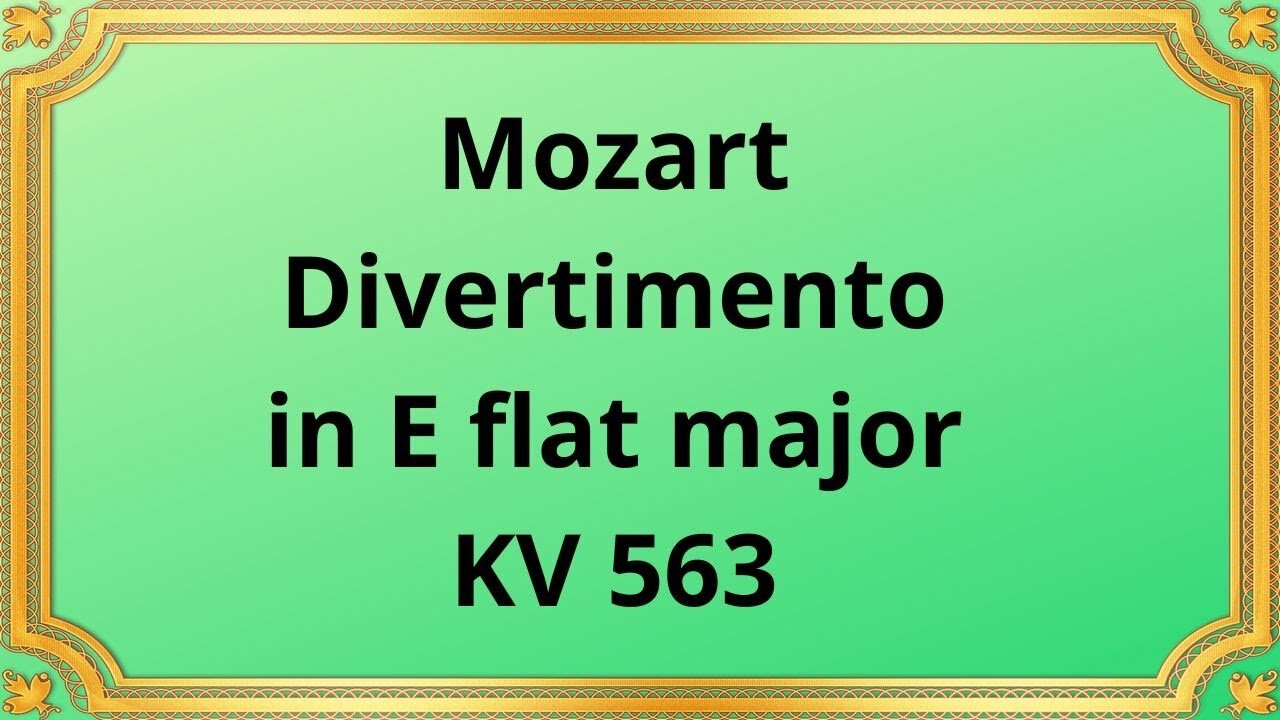Premium Only Content

Wolfgang Amadeus Mozart Divertimento in E flat major KV 563
#Mozart#Chamber_music#Classical_music#Divertimento#Musical_composition
Publication date 1935
Mozart: Divertimento in E-Flat, K. 563, for string trio
The Pasquier Trio:
Jean Pasquier, violin
Pierre Pasquier, viola
Etienne Pasquier, cello
Mozart's Divertimento in E-flat Major, KV 563, is a chamber music masterpiece that is renowned for its intricate and complex musical structure. Written in 1788, this piece showcases Mozart's brilliance as a composer, as well as his ability to create music that is both technically challenging and emotionally engaging. In this essay, we will explore the historical context, musical characteristics, and significance of Mozart's Divertimento in E-flat Major, KV 563.
Mozart composed the Divertimento in E-flat Major, KV 563, during a period of great creativity. At this time, he was exploring new forms of chamber music and expanding the boundaries of classical music. This Divertimento is a prime example of Mozart's innovation, as it combines the string trio of violin, viola, and cello to create a unique and beautiful sound. It was also a time of great change in the music world, as the classical era was coming to an end. Mozart was at the forefront of this movement, and his Divertimento in E-flat Major, KV 563, is a prime example of the mature period of his compositional career.
Mozart's Divertimento in E-flat Major, KV 563, is a six-movement work that showcases the composer's technical virtuosity and emotional depth. The first movement is marked by a lively and playful tempo, with the violin leading the way with a beautiful and complex melody. The second movement is a slow and expressive Adagio, characterized by the use of rich harmonies and expressive melodies. The third movement is a minuet and trio, followed by a variation on a theme in the fourth movement. The fifth movement is a slow and moving Adagio, and the final movement is a lively and energetic Allegro, which brings the divertimento to a satisfying conclusion.
Mozart's Divertimento in E-flat Major, KV 563, is significant for several reasons. First, it is a prime example of Mozart's ability to create music that is both technically complex and emotionally engaging. Second, it showcases the unique sound of the string trio, which was not commonly used in chamber music at the time. Finally, it is a testament to Mozart's remarkable talent as a composer, as it continues to be performed and appreciated by audiences around the world today.
Mozart's Divertimento in E-flat Major, KV 563, is a masterpiece of chamber music that has stood the test of time. It is a significant work that showcases the brilliance and versatility of Mozart's musical genius and his innovation in the classical era. The divertimento is marked by beautiful melodies, rich harmonies, and technical virtuosity, making it a challenging and rewarding piece for performers and listeners alike. It is no wonder that Mozart's Divertimento in E-flat Major, KV 563, continues to be appreciated and celebrated by music lovers around the world.
-
 34:26
34:26
Classical music_Music Inspiration
1 month agoAram Khachaturian Concerto for Violin and Orchestra
802 -
 20:40
20:40
Degenerate Jay
21 hours agoWhy So Many Hate The Fable Game Series
8.83K2 -
 5:19
5:19
Kirill MultitoolOfficial
20 hours agoUSEFUL Survival SKILLS and SMART camping LifeHACKS in the wilderness!
4.71K3 -
 38:57
38:57
PMG
20 hours agoHannah Faulkner and Brandon Tatum | BREAKING THE CHAINS: Exposing the Left’s Manipulation
5.55K -
 0:50
0:50
Sean Unpaved
16 hours ago $9.18 earnedWelcome “Unpaved w/ Sean Salisbury” to Rumble
59.4K14 -
 2:10:09
2:10:09
FreshandFit
9 hours agoKicking Out Old Annoying Hoes In Las Vegas!
87.8K117 -
 25:53
25:53
Stephen Gardner
12 hours ago🔥BREAKING: Trump HATING LAWYER busted in $17 million money laundering scheme!
56K147 -
 20:10
20:10
CartierFamily
18 hours agoAndrew Schulz DESTROYS Charlamagne’s WOKE Meltdown on DOGE & Elon Musk!
135K104 -
 33:56
33:56
The Why Files
9 days agoLegend of the 13 Crystal Skulls | From Mars to the Maya
94.1K44 -
 2:56:14
2:56:14
TimcastIRL
12 hours agoEPSTEIN Files DROP, FBI GOES ROGUE, AG Says They COVERED UP Epstein Case w/Amber Duke | Timcast IRL
221K145